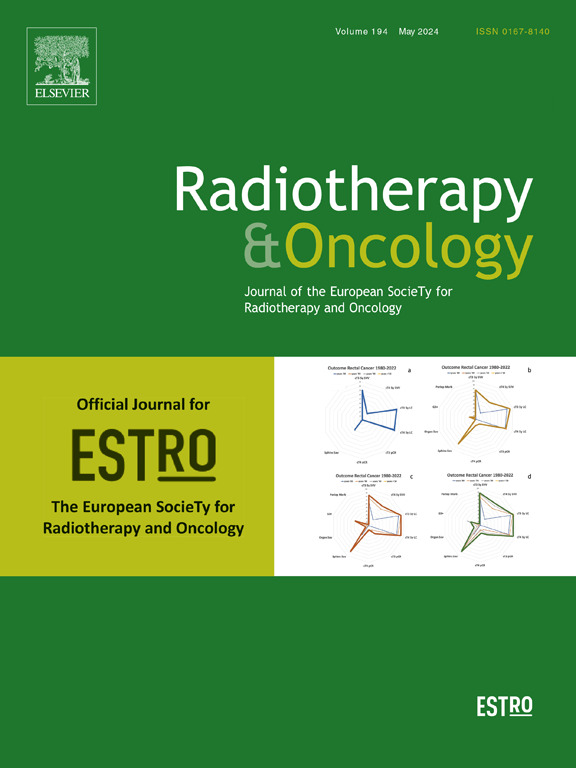Consensus for a postoperative atlas of sinonasal substructures from a modified Delphi study to guide radiotherapy in sinonasal malignancies
IF 4.9
1区 医学
Q1 ONCOLOGY
引用次数: 0
Abstract
Background
Sinonasal and skull base tumor surgery-related morbidity has been reduced by the use of endoscopic endonasal skull base surgery (EESBS). Postoperative radiation therapy (poRT) requires precise definition of target volumes. To enhance the accuracy of poRT planning, histological and radiological correlations are necessary to locate the tumor attachment on poRT CT scans. An accurate atlas of structures resected or identified during EESBS could serve for the interdisciplinary postoperative management of patients, personalizing poRT by adequate radiation dose delivery. The objective of this study was to achieve a consensual segmentation atlas on CT scan with surgeons practicing EESBS and radiation oncologists.
Methods
The sinonasal structures relevant for poRT of sinonasal malignancies were determined by a two-round Delphi process. A rating group of 25 European experts in sinonasal malignancies was set up. Consensual structures emerged and were used to determine the anatomical limits of the retained structures to draft an atlas with expert based relevant structures. The atlas was then critically reviewed, discussed, and edited by another 2 skull base surgeons and 2 radiation oncologists.
Results
After the two rating rounds, 46 structures obtained a strong agreement, 7 an agreement, 5 were rejected and 5 did not reach consensus. The atlas integrating all the selected structures is presented attached.
Conclusion
Consensual segmentation atlas on CT scan might allow, through careful poRT planning to limit the morbidity of poRT while maintaining good local control. Prospective studies are necessary to validate this potential precision medicine-based approach.
改良德尔菲研究就鼻窦下结构术后图谱达成共识,以指导鼻窦恶性肿瘤的放射治疗。
背景:鼻内窥镜鼻内颅底手术(EESBS)的应用降低了鼻窦和颅底肿瘤手术相关的发病率。术后放射治疗(poRT)需要精确定义靶体积。为了提高poRT规划的准确性,需要在poRT CT扫描上进行组织学和放射学相关性来定位肿瘤附着体。在EESBS期间切除或确定的结构的准确图谱可以为患者的跨学科术后管理服务,通过适当的辐射剂量递送个性化poRT。本研究的目的是与从事EESBS的外科医生和放射肿瘤学家在CT扫描上达成共识的分割图谱。方法:采用两轮德尔菲法确定与鼻窦恶性肿瘤相关的鼻窦结构。我们成立了一个由25位欧洲鼻窦恶性肿瘤专家组成的评定小组。双方同意的结构出现并用于确定保留结构的解剖限制,以起草基于专家的相关结构的地图集。随后,图谱由另外两名颅底外科医生和两名放射肿瘤学家进行了严格的审查、讨论和编辑。结果:经过两轮评级,46个结构获得强烈一致,7个结构获得一致,5个结构被拒绝,5个结构不一致。附上了所有选定结构的图谱。结论:CT扫描上双方同意的分割图谱可以通过仔细的poRT规划来限制poRT的发病率,同时保持良好的局部控制。前瞻性研究是必要的,以验证这种潜在的精确医学为基础的方法。
本文章由计算机程序翻译,如有差异,请以英文原文为准。
求助全文
约1分钟内获得全文
求助全文
来源期刊

Radiotherapy and Oncology
医学-核医学
CiteScore
10.30
自引率
10.50%
发文量
2445
审稿时长
45 days
期刊介绍:
Radiotherapy and Oncology publishes papers describing original research as well as review articles. It covers areas of interest relating to radiation oncology. This includes: clinical radiotherapy, combined modality treatment, translational studies, epidemiological outcomes, imaging, dosimetry, and radiation therapy planning, experimental work in radiobiology, chemobiology, hyperthermia and tumour biology, as well as data science in radiation oncology and physics aspects relevant to oncology.Papers on more general aspects of interest to the radiation oncologist including chemotherapy, surgery and immunology are also published.
 求助内容:
求助内容: 应助结果提醒方式:
应助结果提醒方式:


